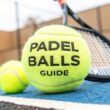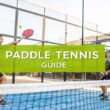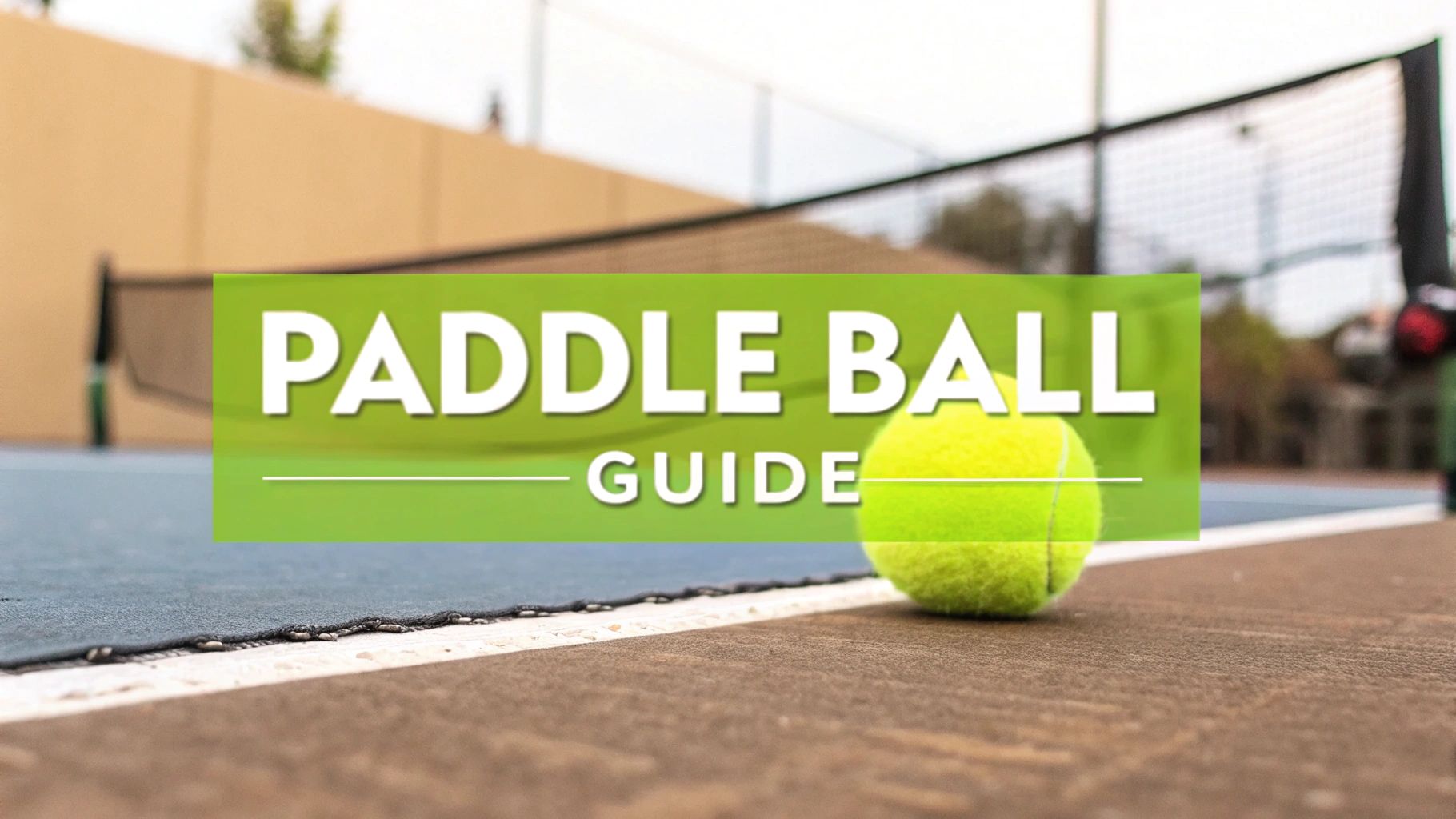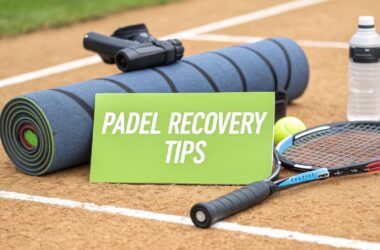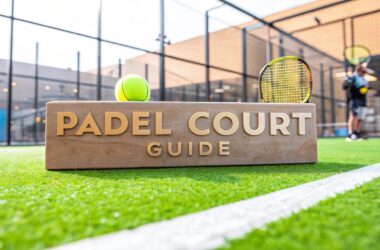So, you want to learn how to play paddle ball? The basic idea is simple: you use a solid paddle to hit a rubber ball against a wall, trying to place a shot your opponent can't legally hit back. It’s a game of quick reflexes and smart placement inside a four-walled court, making it a seriously engaging and fast-paced activity. This guide will walk you through everything you need to know to get on the court and start playing.
Your First Steps into Playing Paddle Ball
Welcome to the energetic world of paddle ball! Before you start swinging, it helps to understand what this game is all about. Unlike its cousins, padel or pickleball, traditional paddle ball is usually a one-on-one battle of endurance and precision against a wall, though playing with a partner in doubles is also a blast. The goal is straightforward: keep the rally going until your opponent messes up.
One of the best things about paddle ball is how accessible it is. You don't need a ton of complicated gear, which makes it a fantastic way to get into racquet sports. Its simplicity is a huge part of the appeal—new players can pick it up fast and start having fun from their very first day.
What Makes Paddle Ball Unique
Paddle ball has a cool history that gives it a unique vibe. You might be familiar with the toy version where a ball is attached to a paddle with an elastic string. That little gadget was actually patented by William R. Lind way back in the 1920s! It was all about improving hand-eye coordination, and by 1937, it was a massive hit.
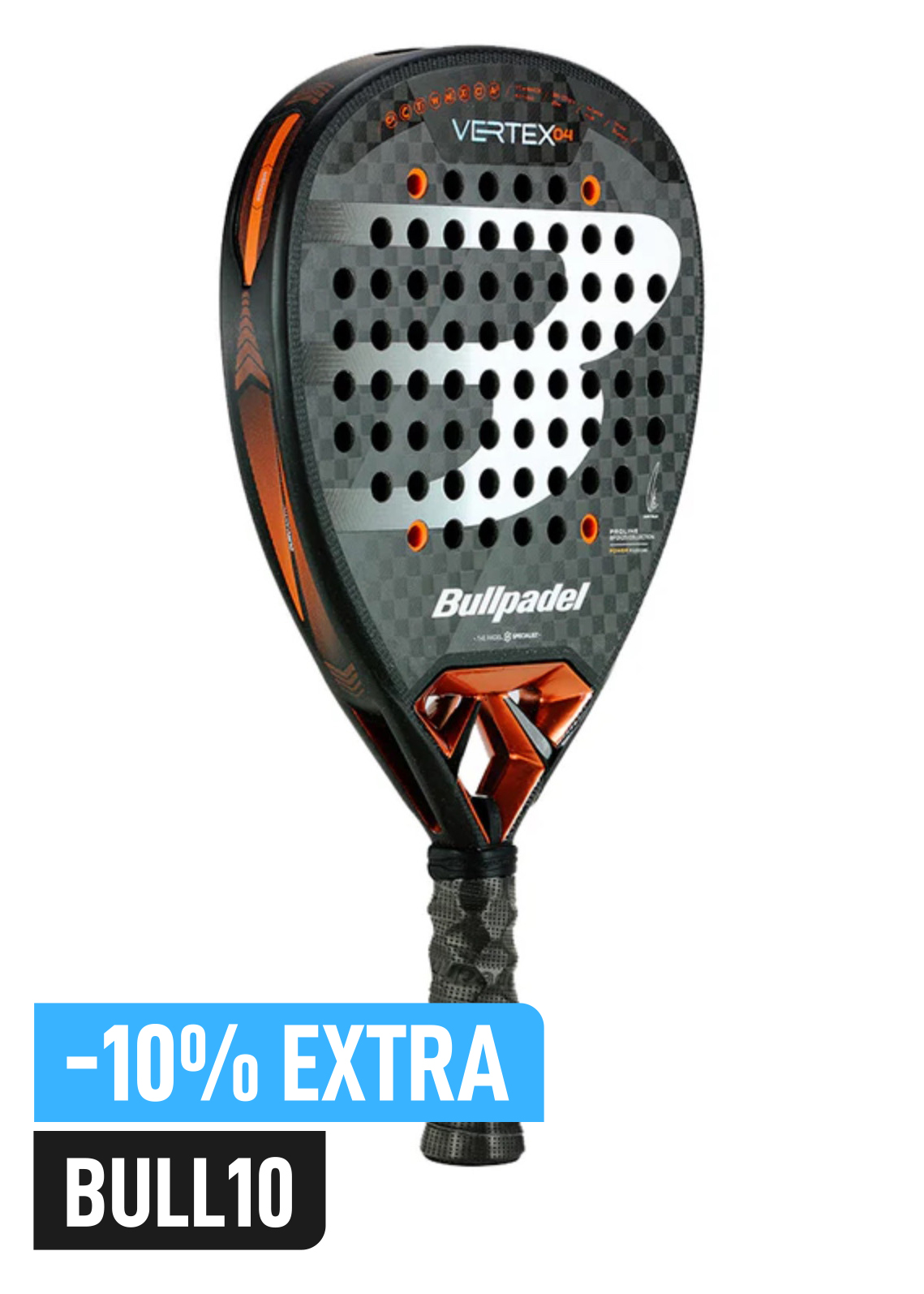
Buy the best padel gear to level up your next game!
CHECK OUT this deal from Padel Market!Get ready to take your game to the next level with the latest padel gear from Padel Market! Fast EU and Worldwide Shipping
The court-based game you're about to learn shares that same DNA of quick, reactive gameplay. It's a fantastic workout that sharpens your agility and strategic mind. But it’s more than just a physical game; it’s a great way to meet people. Building a community is a huge part of any sport, just like what we're seeing with the social scene in padel. You can read more about that here: https://padelrumors.pages.dev/news/padel-social-club/
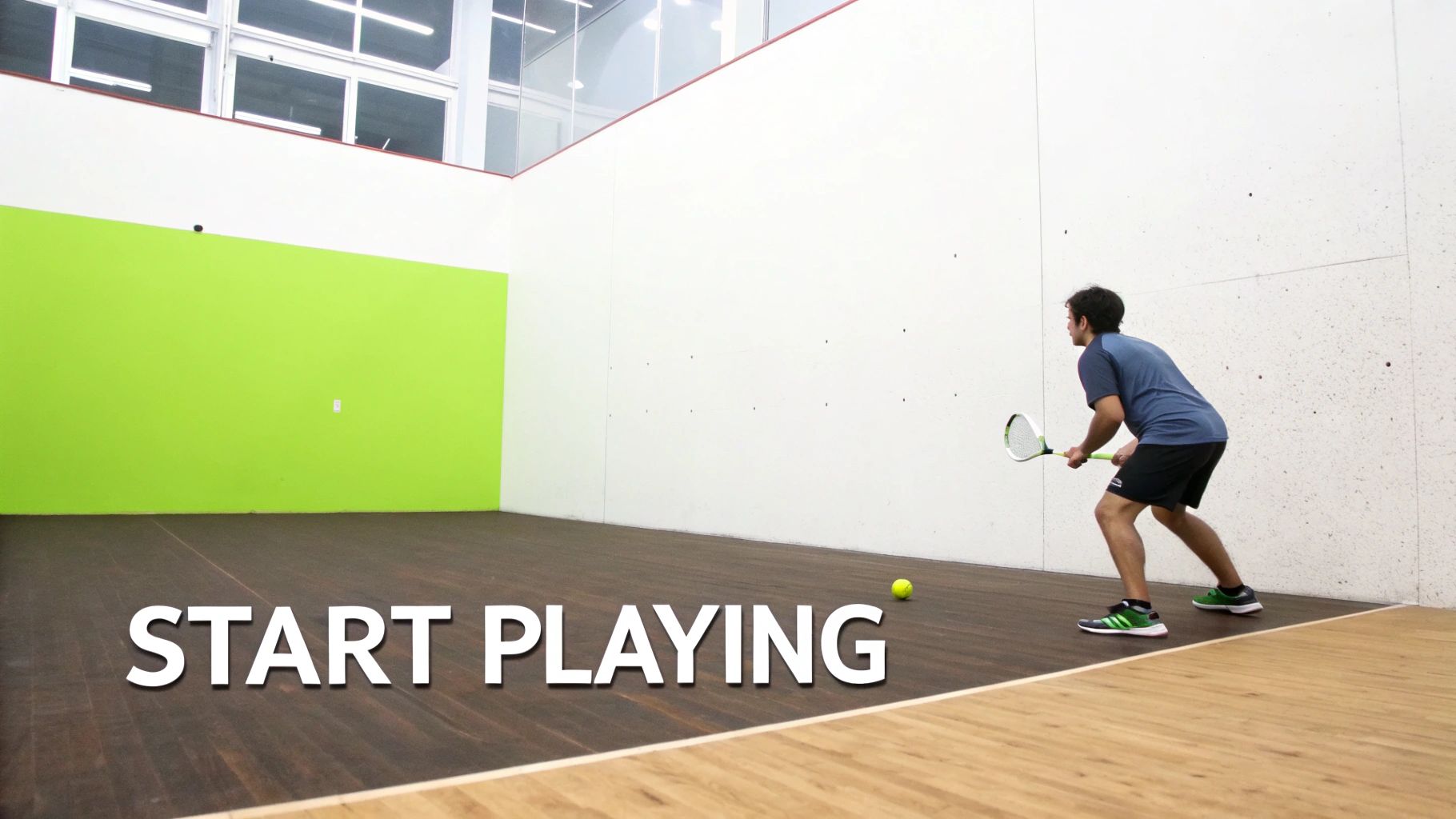
To give you a quick snapshot of the game, here's a simple breakdown of what to expect.
Paddle Ball at a Glance
| Component | What Beginners Need to Know |
|---|---|
| The Court | A four-walled court, similar to racquetball or squash. Using the walls is key! |
| The Paddle | Solid, no strings. Usually made of wood or composite materials. |
| The Ball | A small, pressurized rubber ball. It's lively and bounces a lot. |
| The Objective | Hit the ball against the front wall so your opponent can't return it before it bounces twice. |
| Scoring | Games are typically played to 21 points, and you can only score when you're serving. |
| Players | Can be played one-on-one (singles) or two-on-two (doubles). |
This table should give you a solid foundation as you get started.
As you begin your paddle ball journey, remember it's not just about perfecting your swing. It’s also about having the right attitude on the court. A positive mindset and respect for your opponent are what make the game truly enjoyable. For some great tips on this, check out the essential guide to being a good sportsman.
Choosing Your Gear and Understanding the Court
Before you can even think about hitting the court, you need the right tools for the job. Your equipment has a huge impact on your game, especially when you're just starting out. Making smart choices from day one will make the learning process a whole lot smoother and more fun.
Let's break down the essential gear you'll need and get you familiar with your new playground.
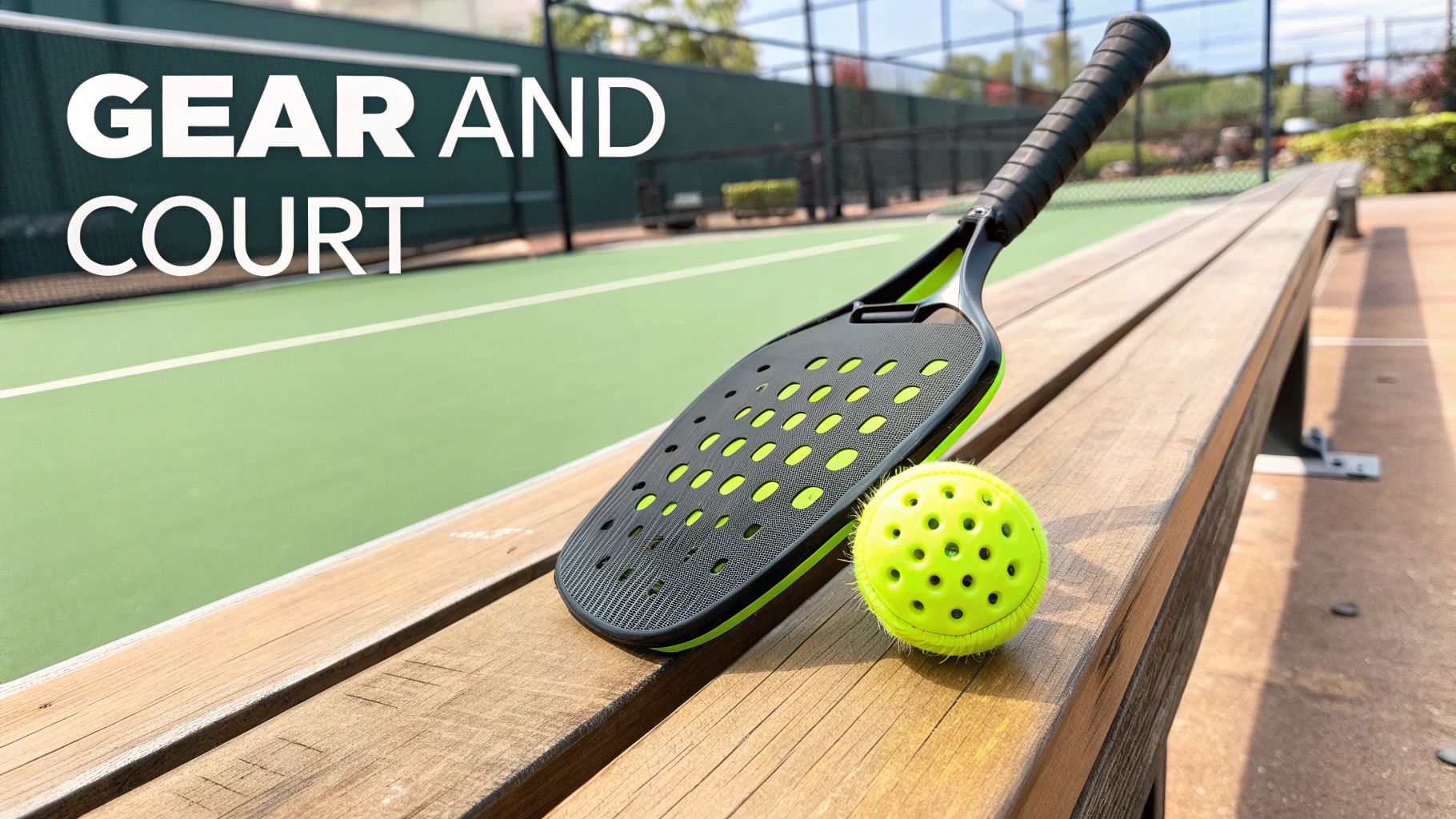
The single most important piece of gear is, you guessed it, your paddle. Unlike tennis rackets with strings, paddle ball uses a solid-faced paddle. Years ago, they were just simple slabs of wood, but modern paddles are way more advanced, often using plastics and high-tech composite materials for better pop and a longer lifespan.
Selecting the Right Paddle
Walking into a shop and seeing a wall of paddles can feel a bit overwhelming. The key is to find one that feels right in your hand and works with your game as it develops. Don't just grab the flashiest one; think about these factors:
- Weight: Lighter paddles give you more control and are much easier on your arm—a perfect combo for beginners. Heavier paddles can generate more power, but they demand more strength and can wear you out quickly.
- Material: Old-school wooden paddles are cheap and give you a great feel for the ball. Composite or graphite paddles cost a bit more but offer a bigger sweet spot (meaning more forgiveness on off-center hits) and more power.
- Grip Size: Your grip has to be comfortable. If it's too small, the paddle can twist in your hand. Too large, and you risk straining your wrist and elbow.
My personal tip for anyone new to the game is to start with a mid-weight composite paddle. It’s the sweet spot, giving you a great blend of power and control without being too tough on your arm while you're still learning the ropes.
Once you get some games under your belt, you'll start to figure out what you like. If you're looking at similar sports, our guide on the best padel racket for beginners has some solid advice that can help here, too.
Understanding the Ball and Court
The ball is a critical part of the game. It’s an unpressurized rubber ball, often with holes, that is way less bouncy than a tennis ball. This is by design—that lower bounce is what creates those long, strategic rallies that make the game so addictive.
Finally, you need to know your way around the court. A standard paddle ball court is an enclosed space with a high front wall. There are only a couple of markings you really need to know to get started:
- The Short Line: This line runs parallel to the front wall. On a serve, the ball has to cross this line before it bounces.
- The Service Line: Running parallel to the short line, this line creates the "service box" where the server has to stand.
That's it. Knowing your paddle, how the ball behaves, and the basic court layout is your first major step. Get these down, and you'll be playing confidently in no time.
Learning the Fundamental Rules and Scoring
Okay, you've got the gear and you know the court layout. Now for the fun part: learning how the game actually works. Understanding the rules and scoring is what turns a friendly rally into a real, competitive match. The good news? The rules are incredibly simple, so you’ll be playing properly in no time.

Buy the best padel gear to level up your next game!
CHECK OUT this deal from Padel Market!Get ready to take your game to the next level with the latest padel gear from Padel Market! Fast EU and Worldwide Shipping
Let's break down the flow of a typical point, from the serve all the way to the final shot.
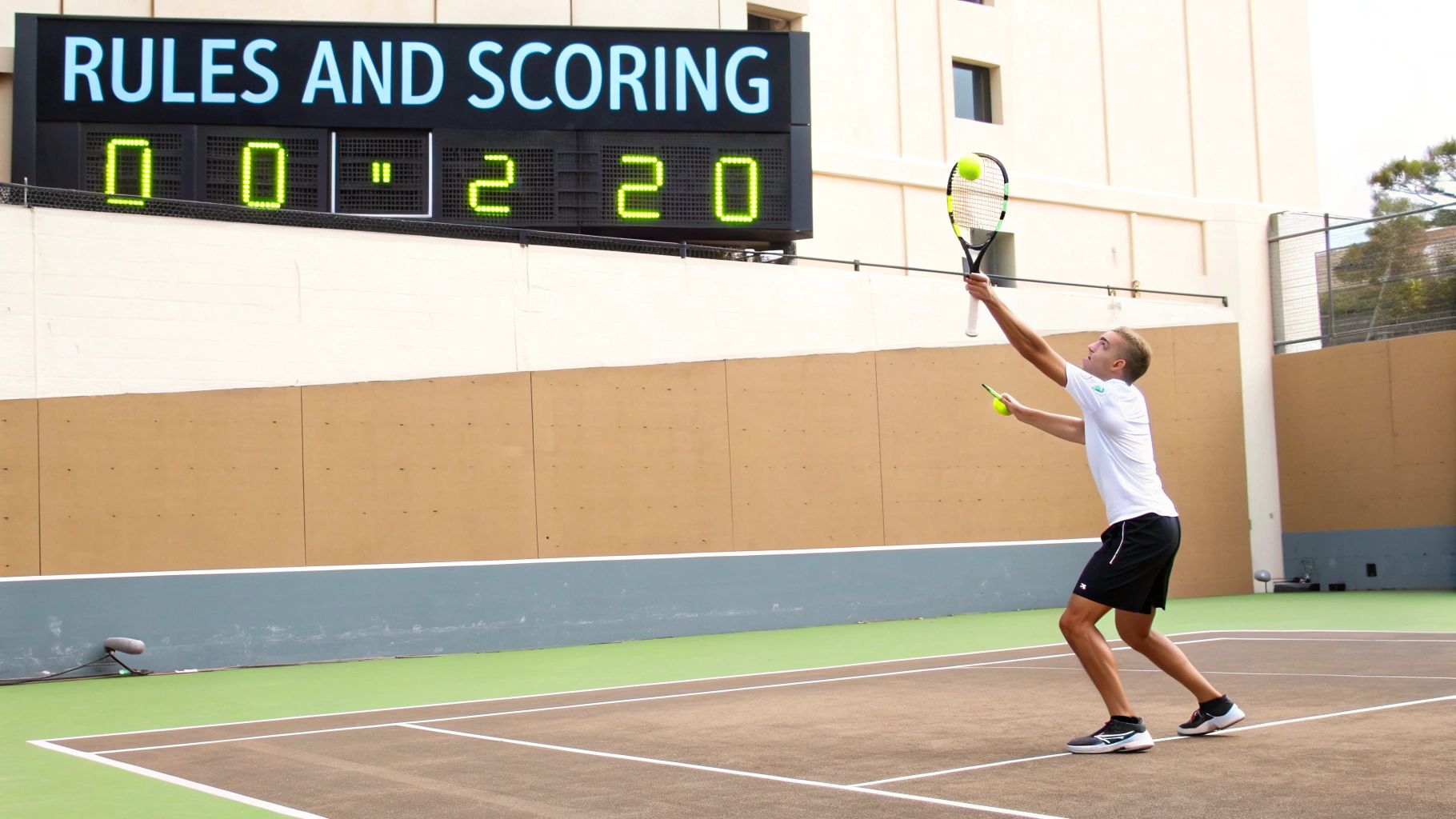
Every single point follows the same basic cycle: serve, rally, and score. You start with a serve to get the ball in play. Then, you and your opponent hit the ball back and forth—this is the rally. The rally goes on until one of you can't make a legal return.
Kicking Off the Point: The Serve
The serve is the only shot in the game you have total control over, so getting it right is a huge advantage. To pull off a legal serve, there are just a few key things to remember.
First, you have to be standing inside the service zone (the box between the short line and the service line). Make sure at least one foot is on the floor in this area when you hit the ball. Before you swing, you must bounce the ball on the floor.
After you strike it, the ball must hit the front wall first. From there, it needs to land on the floor beyond the short line to be considered a good serve.
A huge mistake I see beginners make is trying to blast the serve as hard as possible. A great serve is more about placement and making it tough for your opponent to return. Focus on consistency first, and save the power shots for later.
What Makes a Shot Legal
Once the serve is in, the rally is on. During a rally, every shot has one golden rule: the ball has to hit the front wall before it hits the floor. Simple as that.
You can get creative and use the side and back walls to your advantage. Hitting a shot off a side wall that then caroms onto the front wall is a classic move. But no matter what, the ball can't touch the floor before smacking that front wall.
After the ball comes off the front wall, your opponent has to hit it back before it bounces twice on their side. This back-and-forth is the heart of the game.
Understanding Faults and Scoring Points
A rally ends when someone messes up, which is called a fault. When a fault happens, the other player automatically wins the point. These are the most common ways to lose a point:
- Floor First: The ball hits the floor before it hits the front wall.
- Two Bounces: You don't get to the ball before it bounces a second time.
- Out of Bounds: Your shot lands outside the court's playing area.
- Service Fault: Your serve didn't follow the rules we just covered.
Paddle ball uses what's called "rally scoring." It's super straightforward: a point is scored on every single rally, no matter who served. Most games are played to 21 points, but remember, you have to win by at least two points.
2. Developing Your Basic Strokes and Serves
Alright, let's get to the fun part—actually hitting the ball with some intention. Mastering your basic strokes and serves is what separates simply swatting at the ball from playing a real game of paddle ball. This isn't about brute force. It's about control, consistency, and laying down a solid foundation you can build on.
Everything you do on the court flows from how you hold the paddle. Your grip is the starting point for every single shot, from a delicate touch at the front wall to a powerful passing shot. Get this part right from the beginning, and you'll find everything else falls into place much more smoothly.
Mastering the Continental Grip
For anyone just starting out, the Continental grip is your best friend. It’s the most versatile grip out there, and it’s surprisingly simple to find.
Think of it like you’re shaking hands with your paddle. Just hold the paddle so the face is perpendicular to the ground and grip the handle like you're greeting someone. Your index finger's knuckle should naturally land on the top bevel of the grip. That’s it.
So, why this grip? It’s a neutral position that lets you hit both forehands and backhands without fumbling to change your hand placement mid-rally. In a game as fast as paddle ball, you don’t have time to be thinking about your grip. The Continental gives you a fantastic blend of control and flexibility right out of the gate.
One of the first bad habits players pick up is the "death grip." They squeeze the life out of the paddle, which kills all your wrist flexibility and leads to a stiff, jerky swing. It'll tire you out and can even lead to injury. Keep your hold firm but relaxed. You need that fluid motion to really feel the ball on the paddle.
Executing Your Groundstrokes
Once you're comfortable with the grip, it's time to focus on the two shots you'll use more than any others: the forehand and the backhand. These are your workhorses, the bread and butter of every rally.
The Forehand Stroke
For most players, this is their more natural and powerful shot. It's hit on your dominant side—so, for a right-handed player, it's on your right side.
- Get Ready: As you see the ball coming, turn your body sideways to the front wall. You want your non-dominant shoulder pointing forward. This coiling motion is where your power comes from.
- The Swing: Bring the paddle back in a nice, compact loop. Don’t get wild with it. Keep your wrist firm and your eyes glued to the ball.
- Contact and Finish: Swing forward and aim to make contact with the ball when it’s about waist-high and a little bit out in front of you. The key is to swing through the ball, not just at it. Let your arm continue across your body, finishing with the paddle up high over your opposite shoulder.
The Backhand Stroke
This one’s hit on your non-dominant side and can feel a bit awkward at first, but a solid backhand is crucial if you want to cover the whole court.
- The Setup: It's a similar idea to the forehand, but you'll turn your body even more, so your back is almost partially facing the front wall.
- Swing and Contact: Lead the swing with the edge of the paddle, trying to keep the paddle face relatively flat as you connect with the ball out in front of your body.
- The Follow-Through: Don't cut this part short! A good follow-through is what gives you control. Extend your arm through the shot and finish high, just like you did on the forehand.
For both of these strokes, remember that footwork is everything. Stay light on the balls of your feet, always ready to move. Quick little adjustment steps will get you in the perfect position to hit a clean shot.
Perfecting the Serve
The serve is your one chance in every point to take complete control. In paddle ball, the goal isn't to blast an ace. It's all about placement and starting the point on your terms, which is why serves are hit either underhand or sidearm.
The underhand serve is the most reliable serve for beginners, hands down. Just drop the ball, let it bounce once, and then swing your paddle forward in a smooth, pendulum-like motion. You have to make contact below your waist. Aim for a spot on the front wall that will send the ball deep into your opponent's court, making their return shot more difficult.
For a little more action, you can try the sidearm serve. This can give you a bit more pace and some tricky angles. The motion is like skipping a stone across a pond. You generate force from rotating your body, not just swinging your arm. A good sidearm serve will stay low and fast after it hits the wall, which can really jam up your opponent.
Common Misconceptions About Paddle Ball
When you tell someone you're getting into paddle ball, don't be surprised if you get a confused look. It happens all the time. The name sounds so much like other popular racket sports that it's easy for people to get them mixed up.
Let's clear the air right now. Many beginners immediately think of padel or pickleball, but each of those games is a totally different beast. By understanding what makes paddle ball unique, you'll have a much better grasp of its strategy and, honestly, what makes it so much fun.
Paddle Ball vs Padel
The most common mix-up is with padel, a sport that has absolutely exploded across the globe. Yes, both use paddles, but that’s pretty much where the similarities stop. Padel is a doubles game played on an enclosed court with glass walls.
The game-changer in padel is that you can play the ball after it bounces off those surrounding walls. This creates some wild angles and strategies you just don't see in paddle ball. Invented back in 1969 by Enrique Corcuera in Mexico, padel now has a massive following of over 25 million players worldwide. It’s a global phenomenon with its own distinct culture and gear.
Paddle Ball vs Pickleball
Pickleball is another one that gets thrown into the mix. While it also uses a paddle, pickleball feels more like a combination of tennis, badminton, and table tennis all rolled into one. It’s played on a much smaller court, the net is lower, and the ball is a perforated plastic one—kind of like a Wiffle ball.
A few key things really set pickleball apart:
- The Serve: Every single serve has to be hit underhand.
- The Kitchen: This is a big one. There’s a seven-foot non-volley zone on each side of the net where you’re not allowed to hit the ball out of the air. It forces a different kind of strategic play.
- The Ball: That lightweight plastic ball moves way slower than a rubber paddle ball, which leads to longer rallies that are all about finesse and shot placement.
Understanding these differences helps you appreciate paddle ball for what it is—a fast-paced, wall-based game focused on powerful drives and quick reflexes. It’s not about dinks or wall rebounds; it’s a pure test of agility and shot-making against the front wall.
If you're curious to learn more about how these other sports stack up, check out this great breakdown on the difference between padel and pickleball.
This infographic is a great visual summary of the core techniques you'll need for paddle ball, covering everything from your grip to your first basic shots.
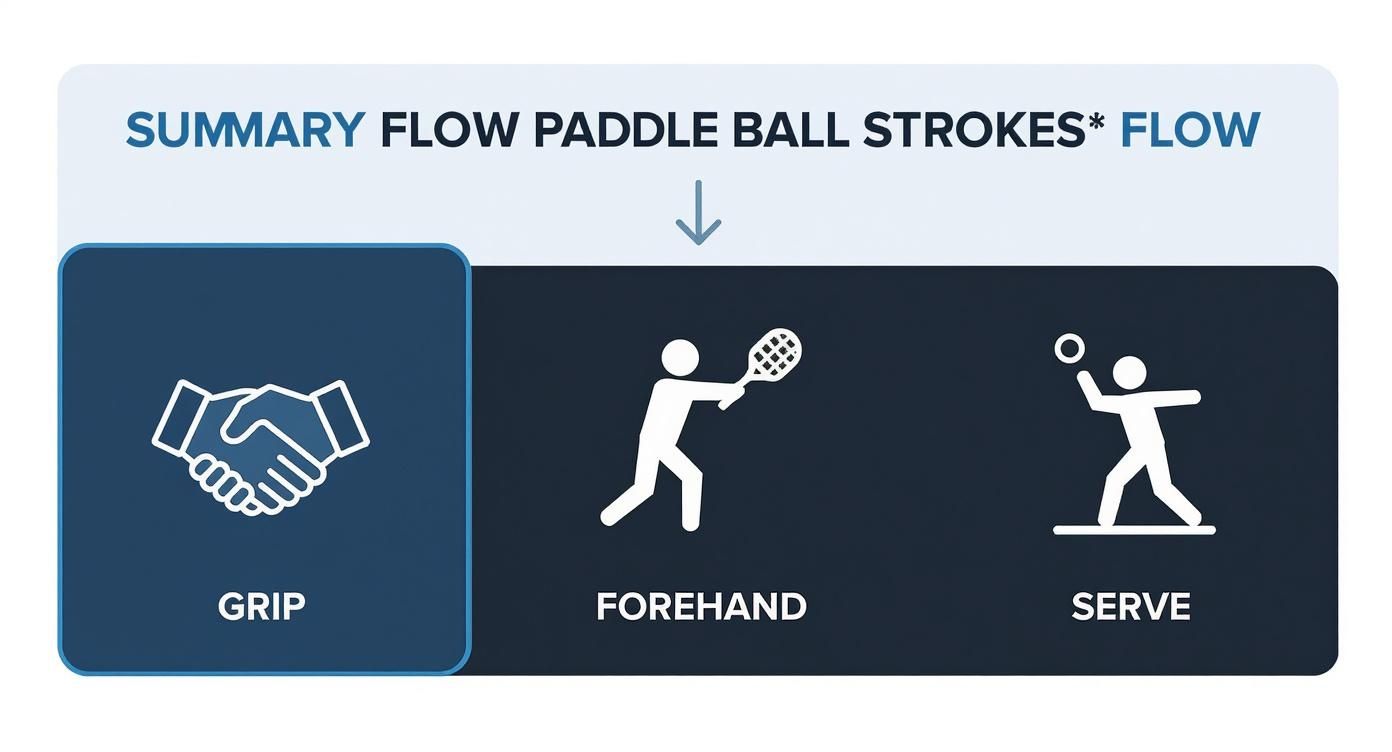
It really reinforces that a proper grip, a solid forehand, and a consistent serve are the three pillars you need to build a strong foundation in the game.
Frequently Asked Questions About Paddle Ball
When you're diving into a new sport, even the best how-to guides can leave you with a few lingering questions. It's totally normal. Think of this as your quick-hit resource for those final "what ifs" and "how tos" that pop up for every new paddle ball player.
We've rounded up some of the most common things beginners ask. The goal is to give you short, straightforward answers so you can clear up any confusion and get back to what matters: playing the game.
Can I Play Paddle Ball by Myself?
You absolutely can, and honestly, it’s one of the best things about the sport. Hitting against the front wall by yourself is an incredible workout and a fantastic way to dial in your skills without the pressure of an opponent.
It’s the perfect setup to sharpen your reflexes and really groove your swing. Want to perfect that backhand down the line? You can spend 15 minutes hitting that one shot over and over again until it’s second nature. Solo practice is where real consistency is built.
What Kind of Surface Is Best for a Paddle Ball Court?
The classic and most common surface for paddle ball is a wooden court, just like what you'd see in a high-quality basketball or racquetball facility. Wood provides that true, predictable bounce that's so crucial for a fast game. It's also got just enough give to be easier on your joints.
While you might run into courts with synthetic or even concrete surfaces, traditional hardwood is really the gold standard for any kind of serious or competitive play.
The consistency of the court surface is a huge deal. A reliable bounce means you can trust your positioning and focus entirely on your swing and strategy, rather than second-guessing where the ball will end up.
How Long Does a Typical Game Last?
A single game of paddle ball, usually played to 21 points, goes by pretty fast. Depending on how long the rallies are and the skill of the players, you’re probably looking at a game time of 20 to 30 minutes.
Of course, a full match—often a best-of-three or best-of-five series—will take a bit longer. A competitive three-game match can easily run for over an hour, giving you a serious cardio workout in a pretty compact timeframe.
- Singles Games: These tend to move a bit quicker since rallies can end faster with only two players covering the court.
- Doubles Games: With four players, rallies often last longer, which can stretch out the total game time.
Getting answers to these common questions is a key part of learning how do you play paddle ball well. The more you know, the more confident you'll feel stepping onto the court, ready for whatever the game throws at you.
At Padel Rumors, we're passionate about helping players at every level fall in love with paddle sports. Whether you're just starting out or looking for pro-level insights, we have the news, guides, and gear reviews you need. Explore our resources and join the global padel community at https://padelrumors.pages.dev.


